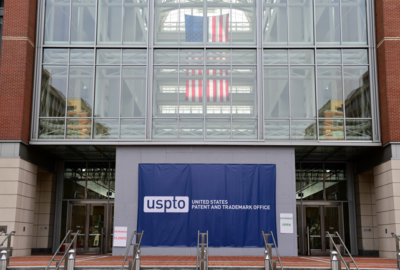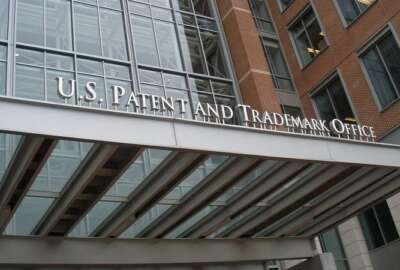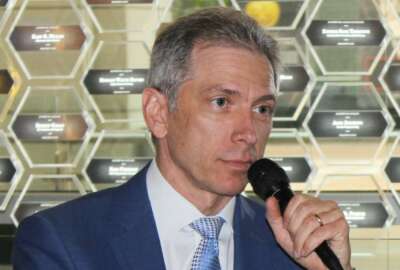

During the pandemic, applications to the Office of Trademarks exploded. For details and how they're coping, the Commissioner for Trademarks, David Gooder.
Best listening experience is on Chrome, Firefox or Safari. Subscribe to Federal Drive’s daily audio interviews on Apple Podcasts or PodcastOne.
People sometimes overlook the T in USPTO. But trademarks are an important enabler of fair and open commerce. In fact, during the pandemic, applications to the Office of Trademarks, part of the Commerce Department’s Patent and Trademark Office, exploded over the last year. For details and how they’re coping, the Commissioner for Trademarks, David Gooder, joined Federal Drive with Tom Temin.
Interview transcript:
Tom Temin: Mr. Gooder, good to have you on.
David Gooder: Thanks for having me, Tom. Good morning.
Tom Temin: All right. So tell us what’s been going on with respect to trademark applications rolling in during this period of this past year and a half or so.
David Gooder: It was interesting, because last winter, trademark filings were, I refer to them as filings or applications, were kind of struggling along and down a little bit. And then the pandemic hit, of course, and everything started dropping, because there was so much uncertainty and people bugging out working from home, everything was different. And then around April or May, things started to tick up, which was a little surprising actually, given what was going on. And that trend continued and continued through the fall and into the winter until we had two huge months in October and the end of September. And now we sit this year at being about 50% higher than last year and approaching a million applications. So it just has absolutely exploded.
Tom Temin: A million applications. Wow. And those are coming from the United States mostly or overseas or a mixture?
David Gooder: Our applications come from about 200 countries, with the biggest percentages from the US. And in terms of this growth, the largest growth areas have been from the US and from China. And then smaller amounts from Europe, other countries.
Tom Temin: And what is the process for getting a trademark approved?
David Gooder: Well, a trademark is something that you created in a business and you get rights by actually using the mark. If you want to make them better, stronger, more perfected, etc, you apply to register at the USPTO. And so you file an application, the process goes along for a few months, it’s examined by an examining attorney. And if everything is good, it gets registered, if there’s something wrong with it, for whatever reason, it’s not registered. For some reason, the applicant has a chance to respond and try to fix that.
Tom Temin: What I’m getting at is the influx of this million applications. How are your examiners able to handle this and are you getting one of those dreaded backlogs building up?
David Gooder: Oh, we absolutely have the backlog and the inventory is significantly higher than it’s ever been. So the examiners as a whole – and there are slightly more than 700 trademark examiners – are working like crazy. I came from the private sector to the trademark office to this position, and it is a really professional hard working bunch. But the inventory is easily double what it normally is.
Tom Temin: All right. And you have taken some steps, though, to deal with that. In your recent blog post you mentioned, let’s start with some IT improvements. What are they and can they happen in time to help speed up things?
David Gooder: Yeah they can. And the thing about the process is trademarks is a game of lots of small pieces in a sense. So incremental improvements in the process, when you spread that out over hundreds of thousands of applications become really significant. So something as small as a bot application that will go check on suspended applications. And if the reason they’re suspended is no longer a problem, that puts them back into the queue. Automating something like that is a small thing, so we’re aiming at all these sort of small pain points- and that’s an example of one of them. One of the other ones isn’t an application that helps us find specimens that shouldn’t have been used or that are being used to try to get around the rules of the office. And oftentimes they’re used by dozens and dozens, if not hundreds of applications – and this particular app will look at a specimen of use, because you have to prove us to get the registration. That’s different than other countries, our system is more robust in that way.
Tom Temin: In other words, we prevent every graphic artists from simply having trademarks on something that’s never left their studios.
David Gooder: That’s correct. There’s no use in the marketplace, you have no real effective trademark rights.
Tom Temin: So basically by weeding or bleeding small increments of time such as checking for this or that individually and automating that across a million applications – that adds up to perhaps millions of hours of time saved.
David Gooder: Yeah, that’s the theory and keeps the examiners time focused on the stuff that really is important and more critical to a trademark being really solid.
Tom Temin: We’re speaking with David Gooder, he’s Commissioner for trademarks at the US Patent and Trademark Office. And just one more detail on that is part of the process to make sure that no one else has something that’s almost identical out there?
David Gooder: You bet it is. So when an application gets filed and examine, one of the key things they look at is the legal requirement that has to be a mark that won’t be likely to cause confusion with another previously filed or registered mark.
Tom Temin: All right. And also with respect to the backlog I think you indicated you’re trying to hire more examiners, and how did you get the budget for that and what does it take to be an examiner?
David Gooder: Good questions. So examiners are attorneys and some of them come from an intellectual property background, let’s say at a private firm and some come from law school and different parts. But they’re all highly trained by us to be able to function as examiners and they’re able to work. We were working almost 70% remotely before the pandemic, so it wasn’t a big switch. So examiners come in, we’ve got a crew that started about two months ago, about 50 examiners, and we’re looking to hire 100. In fact, it’s open right now, to try to deal with this boom.
Tom Temin: Interesting. And I guess my question is, what in the pandemic do you think sparked arise and trademark applications or filings of all things?
David Gooder: That’s a greatly discussed topic as any sort of thing that happens that people kind of scratch their head about. One thing for sure is e-commerce exploded. And so you had a lot of businesses that may have been created during the pandemic or pivoted during the pandemic. Let’s say they were selling kitchen towels. And then they said, Wait a minute, we could make masks.? They said, well we should take our brand and apply for it over here. So there was a fair amount of that. I think there were a lot of people at home saying, what do I really want to do? Do I really want to go back to this job, or that, or maybe it’s my time, maybe this is the world’s way of pushing me to go do something different? Like I said, e-commerce exploded. The other thing is, in some foreign countries, notably China, the government in some provinces was providing subsidies for people to apply. So you had a lot of businesses applying because of that, that creates its own set of questions about whether those are actually valid or not. So you have to look at them carefully.
Tom Temin: And I guess maybe the e-commerce phenomenon has spawned a lot of these applications or filings because you look at Amazon, and you’re trying to find a brand name product just to single them out – and all of a sudden, there’s 10, cheaper imitations of the same thing, under different brands. So that phenomenon of the same thing, only cheaper because I can get it online delivered Tuesday, causes applications.
David Gooder: Yeah. And if you look at some of those brands, some of them you can’t – they’re a seemingly senseless stream of letters – and you can’t pronounce them. And you look at them and you think I don’t know what that brand is. Is it a brand? I don’t know, but I want to buy that thing. Well, in order to take part in Amazon’s program called the Brand Registry, you had to have a trademark application, which eventually becomes a registration hopefully, to get on that. And so a lot of sellers who were pivoting like mad and trying to sell we’re realizing, oh maybe I need to file. Well, the answer is you don’t really, but they did and filed in huge numbers.
Tom Temin: And coming to this office recently, I guess, this early spring, from the private sector where you were a attorney for trademarks for private corporations. What’s your view of how it looks from the inside from the people deciding on these things from the governmental standpoint?
David Gooder: It’s been a fascinating journey, especially because it’s been entirely remote. I got sworn in March 2 last year, we were all bugged out by around the middle of the month. And you’re correct, I’ve been in private practice. I’ve been chief trademark counsel for a big company. And I got to the office and I had worked with the office for years, you can’t be a trademark lawyer in the US and not interact with the Trademark Office. When I got there, I realized how hard working a bunch it is. It’s an incredibly professional bunch. I mean, there’s people who say, well the lawyers in the private sector, maybe they work harder – not what I saw. These folks are amazing. And you start to realize that there are so many issues and so many pieces in it cogs in the wheel and all of the matter. And so now a lot of our journey is how do we take that and make sure that it’s as compatible as it can be with our customers, who are people who file trademark applications, etc., and who rely on the policy work we do. And when you come into it, people joke about you never understand how sausage is made until you start working at the factory – and it is fascinating.
Tom Temin: Well, I have been to USPTO offices, they’re lovely. I hope you get back into your own office pretty soon.
David Gooder: Thank you , yeah me too, there’s not much in mind right now.
Tom Temin: All right. David Gooder is Commissioner for Trademarks at the US Patent and Trademark Office. Thanks so much for joining me.
David Gooder: Thanks for having me, Tom. Take care.
Copyright © 2025 Federal News Network. All rights reserved. This website is not intended for users located within the European Economic Area.
Tom Temin is host of the Federal Drive and has been providing insight on federal technology and management issues for more than 30 years.
Follow @tteminWFED



